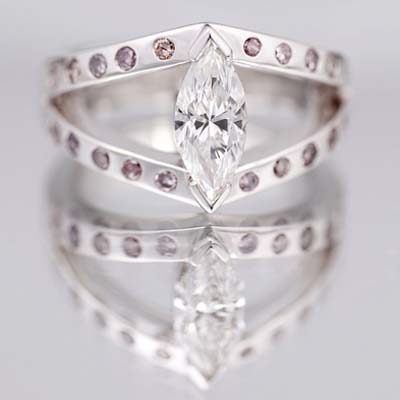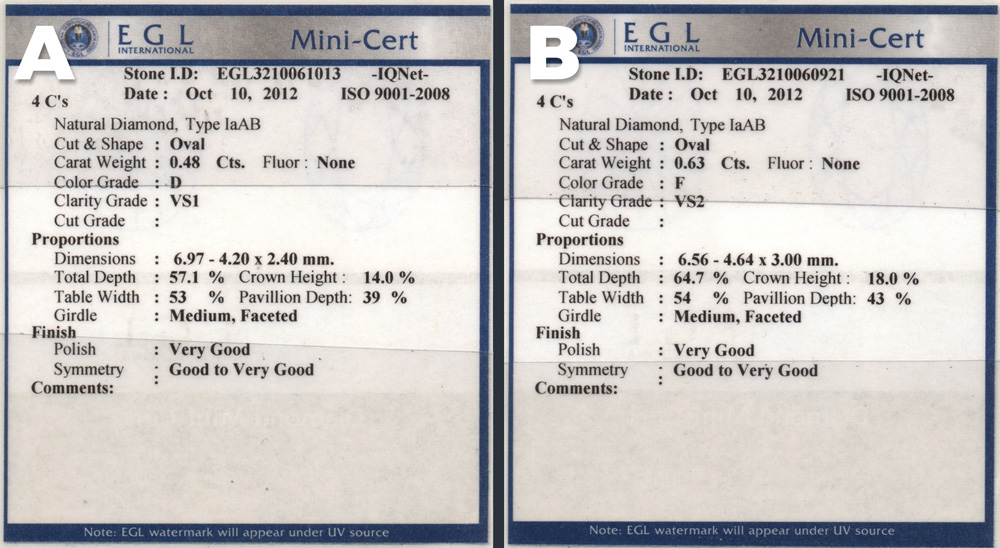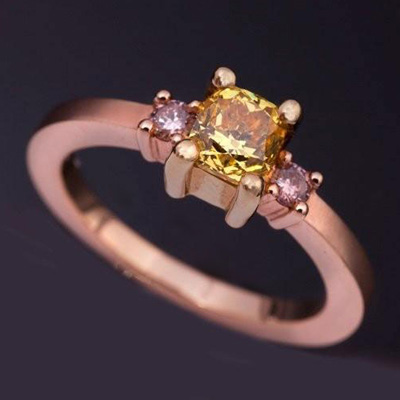The origin of the name 'Diamonds' is from the Greek word 'adamas' – meaning 'unconquerable', since they were recognised as the hardest of all natural minerals from very early times.
Diamonds were once thought to be a scarce resource, but the world's current supply of diamonds is so plentiful, (India, Australia, South Africa, California, Brazil, Russia and Canada), that only a certain quantity is released to the market each year in order to ensure that they continue to fetch the best possible price.
As a result of clever intensive marketing, diamonds have become the traditional stones used in engagement rings and their popularity is firmly entrenched in the modern market. The real value of diamonds is in the higher quallities of their COLOUR (how well the diamond reflects light), CLARITY (how clear the diamond is as a result of any inclusions/defects in it) and CUT (how well the diamond is cut, which affects its brilliance and shine). These qualities will ensure the diamond you choose will keep its value for years to come.
This is why when our customers are making the choice of diamond for their engagement ring, we recommend that they never compromise on the quality of the diamond they buy, but rather on its size. The size of a diamond is determined by its weight. The weight of a diamond is measured in CARATS which is a mass unit used for weighing gems. One carat = 0.2 grams. The term 'points' is used when part of a carat is mentioned: there are 100 points in one carat.
These four characteristics which determine the quality and the price of a diamond are known as THE FOUR Cs.
Colour
- D-F colourless
- G-J near colourless
- K-M faint yellow
- N-R very light yellow
- S-Z light yellow
When you choose a diamond with Aharoni Jewellery we will always attempt to show you quite a few stones, so you can compare them and make your well informed choice for the diamond you like best within your budget. Eytan will show you each diamond with its certificate and highlight both the advantages and disadvantages of each stone. Aharoni Jewellery does not recommend diamonds in a lesser colour than G-H.
Since the setting of a diamond can affect the way its colour appears, we would always recommend setting high colour and clarity diamonds in white metal (Platinum or white gold) in order to minimise the metal colour’s effect on the diamond. Rose gold and yellow gold can help camouflage the yellowness of a not so perfect diamond.
Clarity
- Internally Flawless (IF)
- Very Very Slightly Included (VVS1-VVS2)
- Very Slightly Included (VS1 – VS2 )
- Slightly Included (SI1-SI2 )
- Included (I1-I 3)
The higher the clarity, the fewer imperfections the stone has and the more expensive the stone will be. Aharoni Jewellery does not recommend diamonds of grading lower than SI1 because many times at this clarity grading the imperfection of the stone can be seen with the naked eye.
Cut
The cut of a stone is the aspect which affects its appearance the most: if the angles and the proportions of the diamond are good- its sparkle and brilliance will show through.
We always recommend checking the cut grade of the diamond on its certificate, since this can make a big difference both in the appearance and the price of a stone.
- Excellent (EX)
- Very Good (VG)
- Good (G)
- Fair (F)
- Poor (P)
Carat
The weight of a diamond should always be considered together with the other parameters of the stone, never on its own. Each carat weight has a recommended range of diameters and if a stone does not suit that range it means there are flaws in its cut which affect its proportions and therefore its brilliance.
A diamond which weighs 0.98 carats may well be a better buy than one that is 1.02 carats in weight, if its cut is very good or excellent. There is a huge price jump for diamonds once their weight exceeds 1.0 carat and that jump may not be justified if the slightly smaller diamond still has all its C's up high.
WHITE DIAMONDS- WHICH ONE IS BETTER?
FANCY COLOURED DIAMONDS –WHERE DOES THE COLOUR COME FROM?
White diamonds, as we call them, are most common in the clear, transparent, colourless shade. However, diamonds are available in a variety of colours such as: Yellow, Brown, Green, Blue, Purple, Pink and the most rare of all fancy colour diamonds – Red. The colour in diamonds is due to traces of elements other than Carbon which are included in the stone – the most common one is contents of Nitrogen. In the case of Blue diamonds, it is very small traces of Boron that give it its blue colour. Another factor which affects the colour of the diamond is the conditions which existed underground during its formation, such as the presence of radiation.
The quality of Fancy coloured diamonds is in their colour – the more intense the colour is, the more expensive the diamond is. The way coloured diamonds are cut and polished is different to the way White diamonds are, in order to best show their colour. Fancy coloured diamonds are unique and far more rare than white diamonds and as a result of that, they are worth far more than white diamonds in a similar size. Fancy coloured diamonds make up less than 1% of the total rough diamonds processed each year!
FANCY COLOURED DIAMONDS IN OUR DESIGNS
This is the main reason we, at Aharoni jewellery, love working, designing and creating unique pieces with the unusual, rare diamonds that you can see in our diamond collection. When selecting our diamonds we look for intensity in the colour, which in most cases of natural coloured diamonds comes from the inclusions in the stone. We are always searching for the unusual cuts, which will allow us to design a piece that is unique, as the design of each piece starts with the stone. All our Fancy coloured diamonds from 0.10 carat and bigger and are certified by one of the reputable diamond certification laboratories such as GIA, IGI, EGL, GSL. Our love of colours and unusual shapes in designing our jewellery can be seen in our coloured diamond collection just as much as it can be seen in our coloured gemstone collection – only more sparkly!
EYTAN'S THOUGHTS
These natural creations fascinate us. It is sometimes really hard to believe that nature can create such a huge variety of amazing colours down deep under the ground. We feel extremely fortunate that the work we so passionately love doing brings us close to these beautiful, natural creations of our planet.









